#tools for authors
Text
Resources and Tools for Writers
Resources and Tools for Writers: A Comprehensive Guide
Writing is a beautiful and often challenging endeavor, where words become art, stories take shape, and ideas find their voice. To support the creative journey, writers have access to a vast array of resources and tools that can enhance their craft, streamline their work, and expand their knowledge. In this comprehensive guide, we'll explore the diverse resources and tools available to writers, from writing software and reference materials to writing communities and self-publishing platforms.
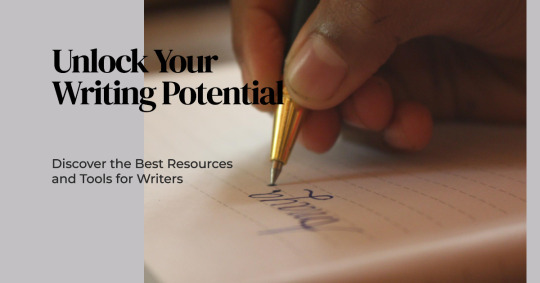
Writing Software and Tools
1. Word Processing Software: Word processors like Microsoft Word, Google Docs, and Scrivener are essential tools for drafting and editing your work. They offer features for formatting, spell-checking, and document organization.
2. Grammar and Editing Tools: Online grammar checkers like Grammarly and ProWritingAid help writers identify and correct grammatical errors, punctuation issues, and style inconsistencies.
3. Mind Mapping and Outlining Tools: Software like MindMeister, Scrapple, and Workflowy can help writers brainstorm, outline their work, and visualize the structure of their projects.
4. Note-Taking Apps: Apps like Evernote and OneNote are perfect for jotting down ideas, collecting research, and organizing notes on the go.
5. Writing Prompts: Websites and apps like Writing Prompts, Reedsy, and The Write Practice provide daily writing prompts and creative exercises to stimulate your imagination.
6. Writing and Word Count Tracking Tools: Tools like NaNoWriMo's word count tracker and online timers like TomatoTimer help writers set goals and monitor their progress.
7. Reference and Research Tools: Tools such as Zotero, Mendeley, and EndNote are useful for managing references, citations, and research materials.
8. Thesaurus and Dictionaries: Online thesauruses like Thesaurus.com and dictionary resources like Merriam-Webster are invaluable for finding synonyms, antonyms, and definitions.
9. Readability Checkers: Tools like Hemingway Editor and Readable.io assess the readability of your writing, helping you create content that's easy to understand.
10. Screenwriting Software: If you're a screenwriter, software like Final Draft or Celtx can assist you in formatting scripts to industry standards.
Reference Materials
1. Style Guides: Manuals like The Chicago Manual of Style, The Associated Press Stylebook, and The Modern Language Association (MLA) Handbook provide guidelines for formatting and citation.
2. Writing Guides: Books like "On Writing" by Stephen King, "Bird by Bird" by Anne Lamott, and "The Elements of Style" by Strunk and White offer invaluable writing advice and wisdom.
3. Dictionaries and Thesauruses: Traditional print dictionaries and thesauruses are still valuable reference materials, especially for writers who prefer the tactile experience of flipping through pages.
4. Writer's Market Guides: The "Writer's Market" series provides information on publishers, literary agents, and markets for various genres.
5. Grammar and Style Books: Resources like "Eats, Shoots & Leaves" by Lynne Truss and "The Elements of Eloquence" by Mark Forsyth offer in-depth exploration of grammar and style.
6. Online Blogs and Articles: Numerous writing blogs and websites, such as Writer's Digest, The Creative Penn, and The Write Life, provide articles, tips, and inspiration for writers.
Writing Communities and Workshops
1. Writing Groups: Local and online writing groups, such as Meetup, Goodreads, and Facebook writing groups, writer’s circle provide a space to share your work, receive feedback, and connect with fellow writers.
2. Writing Workshops: Many organizations and universities offer writing workshops and courses, both in-person and online. They often provide structured learning and feedback opportunities.
3. Critique Partners: Building relationships with critique partners is a valuable way to get constructive feedback on your work. Websites like Critique Circle and Scribophile can help you find critique partners.
4. Author Forums: Websites like Absolute Write Water Cooler and KBoards (for indie authors) are popular author forums where writers can ask questions, share experiences, and seek advice.
5. Writing Conferences: Attending writing conferences and book fairs can help you network with industry professionals, learn from experts, and gain insights into the publishing world.
Publishing Platforms and Self-Publishing Tools
1. Traditional Publishers: If you're pursuing traditional publishing, resources like the Writer's Market guide and QueryTracker can help you find literary agents and publishers. Confused if to go or not for traditional publishing here are 5 Reasons Why Traditionally Published Books Sell Better Than Self-Published Books
2. Self-Publishing Platforms: If you're considering self-publishing, platforms like Amazon Kindle Direct Publishing (KDP), IngramSpark, and Smashwords provide tools and guidelines for self-publishing your work.
3. Book Cover Design Tools: Software like Canva and Adobe Spark can assist with designing eye-catching book covers.
4. Formatting and Layout Services: For professionally formatted books, services like Vellum and Brave Healers Production can help you create professional interior layouts.
5. Book Marketing Tools: Social media networks are essential for book marketing and promotion.
6. Email Marketing Services: Services like Mailchimp and ConvertKit are valuable for building and maintaining a mailing list for your author newsletter.
Income and Rights Management
1. Royalty Tracking Software: Tools like BookTrakr and AuthorEarnings provide insights into book sales, royalties, and income tracking.
2. Copyright and Contracts Resources: Authors should familiarize themselves with copyright law and have legal resources for contract reviews if working with publishers.
Author Platforms and Websites
1. Author Websites: Creating a professional author website is a must. Platforms like WordPress, Wix, and Squarespace offer user-friendly website builders.
2. Blogging Platforms: Blogging can help you connect with readers and showcase your writing. WordPress and Blogger are popular blogging platforms.
3. Social Media: Building a presence on social media platforms like Twitter, Instagram, and Facebook can help you engage with your audience and promote your work.
Financial and Business Tools
1. Tax Resources: As an author, you may need to navigate complex tax matters. Tax software or the services of an accountant or tax professional can be invaluable.
2. Business Tools: Software for bookkeeping, invoicing, and project management can help authors manage their finances and business affairs effectively.
Online Writing Tools
1. Online Writing Platforms: Online platforms like Medium, Wattpad, and Vocal.Media provide opportunities to publish and share your writing with a broad online audience.
2. Collaborative Writing Tools: Tools like Google Docs and Scrivener support collaborative writing projects by enabling real-time editing and sharing. Don’t miss the 5 FREE Writing Tools Authors Must Try In 2023
Conclusion
The journey of a writer is a continuous exploration of creativity and self-discovery. The resources and tools available to writers today are as diverse as the voices and stories they bring to life. This comprehensive guide should serve as a valuable reference for writers looking to enhance their craft, navigate the publishing world, and connect with their audience. Whether you're just starting your writing journey or have been on it for years, these resources and tools are here to support your passion and help you turn your ideas into art.
5 notes
·
View notes
Text
The Anatomy of Punching a Character in the Face
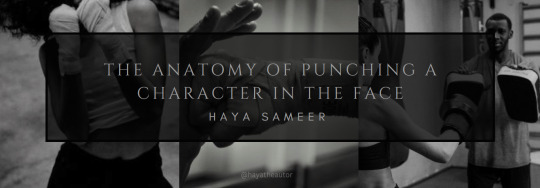
Punching scenes are a staple of action sequences in many genres. Whether it’s an intense brawl, a quick defense, or an emotional outburst, a punch can carry a lot of weight both physically and narratively. As a writer, it’s essential to understand what really happens when a fist meets a face—from the immediate impact to the longer-lasting effects on both the person getting punched and the one throwing the punch.
This guide will help you craft authentic, detailed, and believable punch scenes by exploring different areas of the face, types of punches, and the aftermath of such an impact.
1. Target Areas of the Face and Their Vulnerabilities
A punch isn’t a one-size-fits-all situation. Depending on where the fist lands, the consequences will vary significantly. Different parts of the face have varying levels of vulnerability, and targeting these areas produces different effects, from knockouts to broken bones.
A. Jawline: The Knockout Zone
The jawline is a classic target in many fight scenes, especially when knockout punches are involved. This area is highly vulnerable because a hit here causes the head to snap to the side, leading to a sharp rotational movement of the brain inside the skull. This movement disrupts the brain’s communication and often results in a temporary loss of consciousness—what we commonly refer to as a "knockout."
Common Effects: Dislocation or fracture of the jaw, loss of consciousness, slurred speech, and severe pain.
Visual Aftermath: Swelling around the jawline, bruising, and possible misalignment of the jaw if broken.
B. Nose: Breaking and Bleeding
The nose is another vulnerable target, known for being easily broken. It’s not just a fragile bone structure, but it’s also connected to many blood vessels, meaning a direct punch to the nose often results in immediate bleeding. The nasal bone can fracture, causing difficulty in breathing, and in some cases, the nose may need surgical intervention to reset.
Common Effects: Intense pain, bleeding, difficulty breathing, potential for a broken nose.
Visual Aftermath: Blood running from the nostrils, swelling, and significant bruising around the nose and eyes.
C. Cheekbones (Zygomatic Bones): Bruising and Fractures
The cheekbones are one of the more solid structures in the face but are still susceptible to breaks, particularly from a heavy blow. Damage here can lead to not just bruising, but potentially severe injuries that can affect the entire facial structure.
Common Effects: Fractures of the zygomatic bone, swelling, bruising, and pain extending to the eye socket.
Visual Aftermath: Black eyes, noticeable swelling on one side of the face, and a sunken appearance if the bone is fractured.
D. Forehead: A Hard Target
The forehead is much harder than most parts of the face and is less vulnerable to severe damage. However, punches to the forehead can still cause pain, disorientation, and dazing of the recipient. While it’s less likely to result in a knockout, it’s effective in dazing an opponent, especially if the puncher’s goal is to create an opening for another strike.
Common Effects: Swelling, redness, and potential concussions if hit with enough force.
Visual Aftermath: Redness, minimal bruising, and a dazed expression.
E. Eyes: Black Eyes and Swelling
A punch to the eyes is particularly brutal because the area around the eyes is delicate, and the skin is thin. It’s not just about swelling but also potential damage to the orbital bones. The impact can cause "black eyes," characterized by intense bruising and swelling that may close the eye shut for days.
Common Effects: Swelling, black eyes, potential orbital bone fractures, temporary blurred vision.
Visual Aftermath: Discoloration that starts purple and turns yellowish-green as it heals, swollen shut eyes.
2. Types of Punches
Not all punches are created equal. The type of punch thrown can drastically change the outcome of the scene, both in terms of damage and realism. Understanding these different types of punches will allow you to convey more varied and dynamic fight sequences.
A. Jab: Speed and Precision
A jab is a quick, straight punch, usually thrown with the non-dominant hand. It’s not meant to be a knockout punch but more of a setup punch to create an opening or keep the opponent at a distance. Jabs are fast and can be disorienting, especially if they repeatedly land in quick succession.
Common Effects: Light bruising, potential cuts, and swelling in the area hit.
B. Cross: Power and Impact
The cross is a powerful, straight punch delivered with the dominant hand. It’s often aimed at vulnerable spots like the jaw or nose. Unlike a jab, the cross is meant to deliver a significant amount of force, and when landed properly, it can cause serious damage.
Common Effects: Knockouts, broken bones, severe swelling, and bruising.
C. Hook: Lateral Devastation
A hook is a wide, circular punch that targets the side of the head, particularly the jaw or temple. It’s one of the most powerful punches and is often used with the intent of knocking the opponent out.
Common Effects: Knockouts, severe disorientation, potential for concussions, and jaw dislocations.
D. Uppercut: Lifting from Below
The uppercut is thrown upward, usually aimed at the chin. It’s a devastating punch that can lift the opponent’s head and jolt their brain, leading to knockouts. Uppercuts are especially dangerous when they land cleanly on the jaw or chin.
Common Effects: Knockouts, broken teeth, jaw fractures, and disorientation.
E. Haymaker: Risky but Powerful
A haymaker is a wild, swinging punch delivered with as much force as possible. It’s often thrown with reckless abandon and is easy to dodge, but if it connects, it can deal significant damage. Because of its wide arc, it leaves the puncher exposed to counterattacks.
Common Effects: Knockouts, severe bruising, and possible fractures if landed correctly.
3. Punch Wounds: What They Look Like and Healing
Punches to the face leave lasting marks, some immediately visible and others taking days to fully form. Understanding the aftermath of a punch will help you describe the physical toll on your characters more accurately.
A. Immediate Effects
Swelling and Redness: Swelling can begin almost instantly, particularly in areas with soft tissue like the eyes and lips.
Bruising: Bruises start off as red, then turn purple, blue, and eventually fade into yellow or green as they heal.
Bleeding: Punches to the nose, lips, and even cheeks can result in bleeding, either from the skin breaking or from internal damage like a broken nose.
B. Long-Term Injuries
Black Eyes: Punches near the eyes can lead to bruising that darkens the skin around the eyes, giving it a purplish hue.
Fractures: Broken bones, such as the nose or jaw, may require weeks to heal, and in severe cases, surgery may be necessary.
Scarring: If the skin is cut open, there’s the potential for scarring, especially if stitches are required.
C. Healing Process
Bruises: These typically take about a week to two weeks to heal, with the colors shifting as the body absorbs the blood trapped under the skin.
Fractures: Healing from fractures can take several weeks to months, depending on the severity.
Swelling: Swelling can last anywhere from a few hours to a few days, with cold compresses helping to reduce it.
4. How the Punch Affects the Puncher
While we often focus on the person receiving the punch, it’s important to remember that throwing a punch can also take a toll on the puncher.
A. Physical Strain
Knuckle Damage: Hitting a hard surface, like a jaw or forehead, can cause damage to the puncher’s knuckles. This is known as a “boxer’s fracture,” where the small bones in the hand break due to impact.
Wrist Injury: If the punch is not aligned correctly, the wrist can absorb too much force, leading to sprains or breaks.
Fatigue: After multiple punches, especially in a drawn-out fight, the puncher can become fatigued, leading to less powerful or accurate strikes.
B. Emotional and Psychological Effects
Adrenaline Rush: For inexperienced fighters, throwing a punch can lead to an adrenaline surge, which can cause tunnel vision or reckless behavior.
Moral Conflict: If the puncher is not used to violence, they may experience guilt or shock at the damage they’ve caused, especially if the recipient is significantly injured.
5. Psychological Impact of Receiving a Punch
A punch to the face doesn’t only cause physical damage. For the recipient, it can have a lasting psychological effect, especially if the punch was unexpected or in a vulnerable situation. Writing this aspect adds depth to your characters and shows that a punch is more than just physical pain.
A. Shock and Fear
Fight or Flight Response: Getting punched can immediately trigger a fight-or-flight reaction. Some characters might freeze or retreat, especially if they’ve never been in a physical altercation before.
Loss of Confidence: For characters not used to violence, being punched in the face may cause a significant loss of confidence. They may question their own strength, bravery, or ability to defend themselves.
Increased Aggression: Alternatively, the punch may trigger a rage-fueled response, pushing the character into aggressive, reckless action.
B. Embarrassment and Humiliation
Public Fights: If the punch occurs in front of others, there’s often an added layer of humiliation. Characters might feel embarrassed, even if they weren’t at fault.
Internalizing the Event: The recipient of the punch may carry the emotional impact for a long time, replaying the event in their mind, feeling shame, or seeking revenge.
C. Post-Traumatic Stress
Lingering Anxiety: In extreme cases, receiving a punch can cause anxiety or even post-traumatic stress disorder (PTSD). Characters who’ve experienced significant trauma might relive the event through flashbacks or become hyper-vigilant, avoiding confrontations in the future.
Fear of Future Confrontations: A character who’s been severely beaten might actively avoid scenarios where they could be hit again, making them overly cautious or paranoid.
6. Writing Tips: Making It Believable
Writing a punch scene isn't just about describing the physical action. To make the moment believable and impactful, you’ll need to consider various elements—from pacing and sensory details to character psychology and aftermath. Here’s how to make your punch scenes authentic:
A. Build Tension Before the Punch
Foreshadowing Conflict: Build up the tension before the punch is thrown. Is the character agitated? Are there verbal warnings or body language that suggests things are escalating? By slowly ramping up the tension, the eventual punch feels earned and inevitable.
Use Dialogue: A heated exchange of words can make a punch more meaningful. If the punch follows a particularly cutting remark or threat, it adds weight to the action.
B. Focus on Sensory Details
Physical Sensations: Describe not just the punch itself, but how it feels. Does the skin split? Does the puncher’s knuckles scrape against teeth or bone? Is there an immediate sting or delayed throbbing pain?
Sound: The sound of a punch can enhance the realism of the scene. A dull thud as a fist connects with soft tissue, the crack of a bone breaking, or the splatter of blood hitting the floor are all effective auditory details.
C. Show Immediate and Delayed Reactions
Physical Reaction: After being punched, characters rarely shake it off immediately. Staggering, falling, or momentarily losing their vision are realistic reactions. You can also show how the puncher feels—did their hand hurt from the impact?
Emotional Fallout: Punches are often emotional events. Show how your characters feel right after—whether it’s satisfaction, regret, or shock. The emotional weight of a punch can be just as impactful as the physical consequences.
D. Consider the Aftermath
Healing Process: Don’t forget that punches have a lasting impact. A black eye will take days to heal, and a broken nose could require medical attention. Characters might have to deal with soreness, swelling, or difficulty talking and eating.
Ongoing Tension: A punch can dramatically shift relationships. A once-trusting friendship could be shattered, or a bitter rivalry could be born. Make sure to carry the emotional weight of the punch forward in your story.
7. Common Misconceptions About Punching
Many writers fall into the trap of perpetuating unrealistic portrayals of punches. These misconceptions can make your scenes feel less authentic or overly cinematic. Here’s how to avoid them.
A. The Myth of the "Clean Knockout"
Reality: A punch to the jaw might cause a knockout, but it’s not always instant. In real life, knockouts are often messy and unpredictable. The recipient might stagger or struggle before finally losing consciousness, and they could wake up with serious concussions, memory loss, or nausea.
B. Punches Always Cause Immediate Bleeding
Reality: While a punch to the nose often causes immediate bleeding, not all punches result in visible blood. Even when skin splits, it might take a moment for blood to pool and become visible. Bruising and swelling often take hours to fully appear.
C. Punching Doesn’t Always Lead to a Win
Reality: Throwing a punch doesn’t guarantee victory. The puncher could hurt themselves, miss entirely, or end up escalating a fight they weren’t prepared for. Additionally, punches to the forehead or temple might not have the knockout effect portrayed in movies—they could just make the puncher’s hand hurt more than the opponent.
Looking For More Writing Tips And Tricks?
Are you an author looking for writing tips and tricks to better your manuscript? Or do you want to learn about how to get a literary agent, get published and properly market your book? Consider checking out the rest of Quillology with Haya Sameer; a blog dedicated to writing and publishing tips for authors! While you’re at it, don’t forget to head over to my TikTok and Instagram profiles @hayatheauthor to learn more about my WIP and writing journey!
#hayatheauthor#haya's book blog#haya blogs#writing community#quillology with haya#writing tools#writer things#writing advice#writer community#writing techniques#writing prompt#writing stuff#creative writing#ya writing advice#writing tips and tricks#writer tools#writers of tumblr#writer blog#writers block#quillology with haya sameer#writers on tumblr#writerscommunity#writer stuff#author help#author advice#author#writing inspiration#writeblr#novel writing#on writing
1K notes
·
View notes
Text
Okay writers listen up
I'm gonna tell you about how I wrangled my shitbird brain into being a terrifying word-churning engine and have written over 170K words in under a year.
I wanna be clear that before unlocking this Secret Technique I was a victim of my unmedicated ADHD, able to start but never finish, able to ideate but not commit and I truly and firmly believed that I'd never write a novel and such a thing was simply outside of my reach.
Now I write (and read!!) every day. Every. Single. Day. Like some kind of scriptorial One Punch Man.
Step the First
Remove friction between yourself and writing.
I personally figured out how to comfortably write on my phone which meant I didn't have to struggle with the insurmountable task of opening my laptop.
I don't care if this means you write in a Discord server you set up for yourself, but fucking do it. Literally whatever makes you write!
(if you do write somewhere that isn't a word processor PLEASE back your work up regularly!)
Step the Second
Make that shit a habit. Write every day.
For me, I allow myself the grace that ANY progress on writing counts. One sentence? Legal. Five thousand furious hyperfixated words? Also legal.
Every day, make progress. Any progress.
I deleted Twitter from my phone and did my best to replace doomscrolling with writing. If I caught myself idly scrolling I'd close whatever I was looking at and open my draft and write one (1) sentence until I made THAT a habit, too.
Step Two-point-Five
DO NOT REWRITE. If you are creating a first draft, don't back up or restart. Continous forward motion. Second drafts and editors exist. Firsts are for ripping the fucking thing out of your brain.
If you're working on revisions after an editor or beta readers or whoever has given you feedback, then you can rewrite that's OK (and it counts as your writing for the day!)
Step the Third
Now that you've found a comfortable way to write and are doing it every day, don't stop. Keep doing it. Remember, just one sentence is all you need. You can always do more, but if one lousy sentence is all you can manage then you're still successfully writing.
Remember: this is what worked for me. Try things until you find what works for you.
You can do it. I believe in you.
#am writing#writing resources#original writing#Writer#writeblr#author#Author resources#writing tools#writing#writing tool#long post#text post
5K notes
·
View notes
Text
A quick reminder that fanfics shouldn't be reposted anywhere ever unless you have the express permission of the author.
You want to translate a fic? Awesome, ask!
You want to make a podfic? Amazing, ask!
But it's disrespectful to an author to take their content and repost without telling them, EVEN if you did transformative work on it.
Yes, fanfics are free, and on ao3 they are even downloadable, but they are downloadable for private use! For you to have on your kindle and read in whatever format best suits you. Not to be REPOSTED on another site!
Please, please, if you want authors to continue posting stories publically you have to respect an author's desire to maintain some level of ownership over their work.
#fanfic#ao3#this is about lore.fm and the amount of readers I've seen not understanding the issue!#Coming from somebody who has terrible sight and often relies on text to speech#The issue isn't the text to speech tool it's the scraping ao3 and reposting author's work without consent part
1K notes
·
View notes
Text
Master Dialogue Writing Techniques for Engaging Fiction (For Writers)
(Beware, long post!)
As fiction writers, we all know that effective dialogue is essential for bringing our stories and characters to life. After all, the way our protagonists, antagonists, and supporting players speak to one another is one of the primary ways readers get to know them on a deep, intimate level. Dialogue reveals personality, uncovers motivation, and propels the narrative forward in a way that felt narration simply can't match.
But nailing natural, compelling dialogue is easier said than done. It's a craft that takes serious skill to master, requiring writers to have a keen ear for authentic speech patterns, a nimble handle on subtext and implication, and the ability to strike that delicate balance between being true to real-world conversation while also keeping things snappy, dynamic, and laser-focused on the story at hand.
If you're someone who struggles with crafting dialogue that truly sings, never fear. In this in-depth guide, I'm going to dive deep into the techniques and best practices that will help you elevate your dialogue writing to new heights. By the end, you'll have a toolbox full of strategies to ensure that every exchange between your characters is as gripping, revealing, and unforgettable as possible.
The Fundamentals of Effective Dialogue
Before we get into the more advanced nuances of dialogue writing, let's start by covering some of the foundational principles that all great fictional conversations are built upon:
Reveal Character One of the primary functions of dialogue is to give readers a window into who your characters are as people. The way they speak — their word choices, their tone, their body language, their turns of phrase — should provide vivid insight into their personalities, backgrounds, values, quirks, and emotional states.
Think about how much you can glean about someone just from how they communicate in real life. Do they use a lot of slang and shorthand? Are they verbose and flowery with their language? Do they struggle to make eye contact or fail to respond directly to questions? All of these subtle linguistic cues are powerful tools for crafting multi-dimensional characters.
Drive the Plot Forward While revelations about character are crucial, you also want to ensure that your dialogue is constantly pushing the story itself forward. Each exchange should feel purposeful, moving the narrative along by introducing new information, triggering plot points, creating conflict, or prompting characters to make pivotal decisions.
Dialogue that feels aimless or extraneous will ultimately bore readers and detract from the forward momentum of your story. Every line should have a clear intent or function, whether it's uncovering a hidden truth, setting up a future complication, or escalating the tension in a high-stakes moment.
Establish Distinct Voices In a story featuring multiple characters, it's crucial that each person has a clearly defined and differentiated way of speaking. Readers should be able to tell who's talking just from the rhythm, diction, and personality of the dialogue, without any additional context clues.
This doesn't mean every character has to have an over-the-top, hyper-stylized way of communicating. In fact, the most effective character voices often feel grounded and natural. But there should still be distinct markers — whether it's word choice, sentence structure, tone, or speech patterns — that make each person's voice instantly recognizable.
Convey Subtext While the literal words being spoken are important, great dialogue also traffics heavily in subtext — the unspoken emotional undercurrents, power dynamics, and hidden agendas that simmer beneath the surface of a conversation.
The most compelling exchanges happen when characters are communicating on multiple levels simultaneously. Perhaps they're saying one thing out loud while their body language and tone convey a completely different sentiment. Or maybe they're engaged in a subtle war of wits, trading verbal jabs that reveal deeper wells of resentment, attraction, or vulnerability.
Mastering the art of subtext is key to creating dialogue that feels layered, lifelike, and imbued with dramatic tension.
Strategies for Writing Snappy, Realistic Dialogue
Now that we've covered the foundational principles, let's dive into some specific techniques and best practices that will take your dialogue writing to the next level:
Omit Unnecessary Details One of the biggest mistakes many writers make with dialogue is bogging it down with too much extraneous information. In real life, people rarely speak in perfectly composed, grammatically correct full sentences. We stumble over our words, interrupt each other, trail off mid-thought, and pack our speech with filler words like "um," "uh," and "you know."
While you don't want to go overboard with mimicking that messiness, you should aim to strip your dialogue of any overly formal or expository language. Stick to the essentials — the core thoughts, feelings, and information being exchanged — and let the subtext and character voices do the heavy lifting. Your readers will fill in the gaps and appreciate the authenticity.
Master the Art of Subtext As mentioned earlier, crafting dialogue that's rich in subtext is one of the keys to making it feel gripping and lifelike. Think about how much is often left unsaid in real-world conversations, with people dancing around sensitive topics, conveying hidden agendas, or engaging in subtle power struggles.
To layer that sense of unspoken tension into your own dialogue, consider techniques like:
• Having characters contradict themselves or say one thing while their body language says another
• Utilizing loaded pauses, interruptions, and moments of uncomfortable silence
• Injecting subtle sarcasm, skepticism, or implication into a character's word choices
• Allowing characters to talk past each other, missing the unspoken point of what the other person is really saying
The more you can imbue your dialogue with that layered, emotionally-charged subtext, the more it will resonate with readers on a deeper level.
Establish Distinct Voices As mentioned earlier, ensuring that each of your characters has a clearly defined and differentiated speaking voice is crucial for great dialogue. But how exactly do you go about accomplishing that?
One effective strategy is to give each person a unique set of verbal tics, idioms, or speech patterns. Maybe one character is prone to long-winded, flowery metaphors, while another speaks in clipped, efficiency-minded sentences. Perhaps your protagonist has a habit of ending statements with questioning upticks, while the sarcastic best friend always punctuates their barbs with an eye roll.
You can also play with differences in diction, syntax, and even accent/dialect to further distinguish how your characters communicate. The key is to really get to know the unique personality, background, and psychology of each person — then let those elements shine through in how they express themselves.
Lean Into Conflict and Confrontation When it comes to crafting gripping dialogue, conflict is your friend. The most compelling exchanges often arise from characters butting heads, engaging in verbal sparring matches, or working through deep-seated tensions and disagreements.
Conflict allows you to showcase the high stakes, unresolved needs, and deeper emotional currents that are driving your characters. It forces them to make bold choices, reveals aspects of their personalities that might not otherwise surface, and generates the kind of dramatic tension that will really hook your readers.
Of course, you'll want to avoid making every single dialogue scene a full-blown argument. But learning to sprinkle in well-placed moments of friction, confrontation, and clashing agendas is a surefire way to elevate the energy and impact of your character interactions.
Read Your Dialogue Out Loud One of the most valuable tricks for ensuring your dialogue sounds natural and lifelike is to read it aloud as you're writing. Hearing the words out loud will quickly expose any clunky phrasing, overly formal grammar, or inauthentic rhythms that would otherwise go unnoticed on the page.
Pay close attention to how the dialogue rolls off your tongue. Does it have a smooth, conversational flow? Or does it feel stilted and unnatural? Are your characters' unique voices shining through clearly? Are there any spots where the back-and-forth starts to drag or feel repetitive?
Actively listening to your dialogue — and making adjustments based on how it sounds in the real world — is an essential part of the writing process. It's one of the best ways to refine and polish those character interactions until they feel truly alive.
Hopefully, this can help you all!
The key is to always keep your focus on authenticity. Ask yourself: how would real people actually speak?
Hey fellow writers! I'm super excited to share that I've just launched a Tumblr community. I'm inviting all of you to join my community. All you have to do is fill out this Google form, and I'll personally send you an invitation to join the Write Right Society on Tumblr! Can't wait to see your posts!

#writing#thewriteadviceforwriters#writeblr#creative writing#writing tips#on writing#writers block#how to write#writers and poets#writers on tumblr#authoradvice#author#fiction#indie author#writer#publishing#book writing#book quote#bookblr#books#writing advice#fiction writing#writing blog#writing tools#writing resources#novel writing#writer community#fantasy novel#readers#reading
802 notes
·
View notes
Note
May I ask the software you use to write?
Congratulations on getting so much done!
Thank you so much. And, of course.
I use the Reedsy Book Editor for all of my writing projects, and I've been using it for about three years now. I also have experience with other amazing softwares, and I would love to create more tutorials on them if you need me to.
Here's a quick tutorial on how to use the Reedsy Book Editor.
When you visit the website, the first thing you'll come across is this page. It's a completely free writing tool with a fantastic interface. All you need to do is sign up with your Google or Facebook account.

After you've completed the sign-up process and provided some information about yourself, you will be directed to this page. Please locate the "Books" option in the website's header.
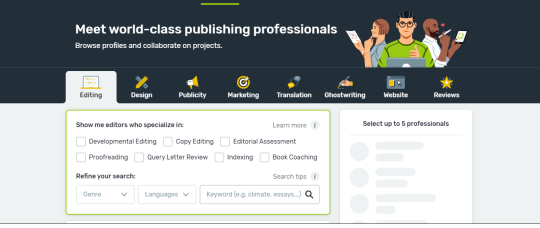
Feel free to give your book/WIP (Work in progress) a title. Remember, it's okay if it's not your final title, as you can always change it in the settings of your book later.

Once you've created it, you can take your time and when you're ready, you can click "Write.”
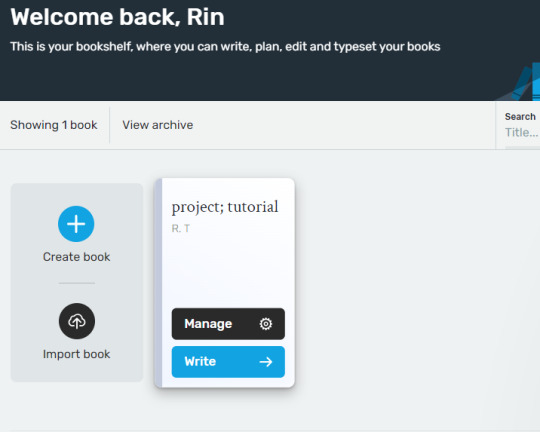
Once you click "Write," you'll be directed to the next page. There, you'll find your chapters, the space to write your manuscript, and a sidebar with various helpful features provided by Reedsy.
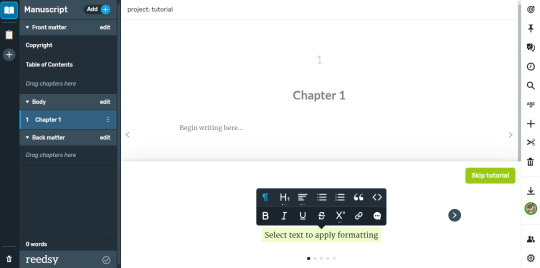
Then, you can choose any name for your chapter that feels meaningful to you.
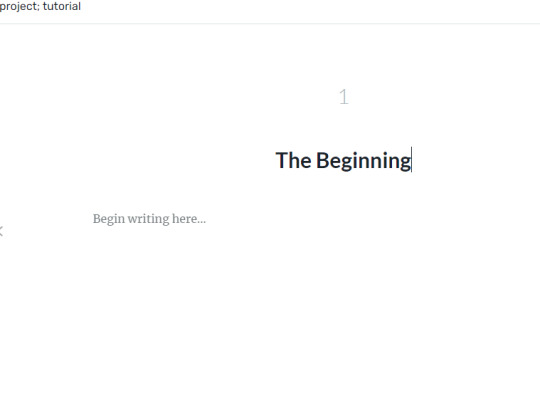
You can also track your writing goals for your specific manuscript or book. This feature provides insights into your writing habits, such as the days you've written and the number of words you've written. You can also set a target word count goal for the manuscript, and you also have the option to set manual writing goals. Additionally, you can check the word count in your current chapter from the bottom of the widget.
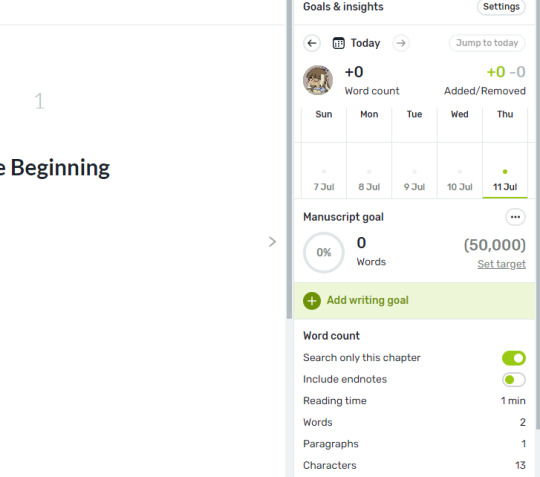
You have the option to set a deadline and choose the days that work best for you to write. This will help Reedsy estimate a realistic word count goal for you.

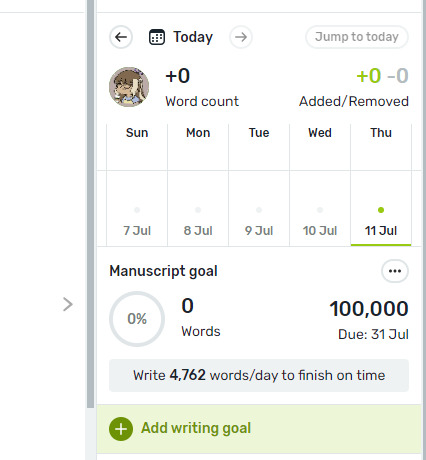
Remember that on Reedsy, there's a new beta feature that allows you to plan and outline your novel without having to leave the website. It offers note cards for you to jot down the plot and scenes from your novel, which can serve as a helpful guide and provide a simple outline to support your writing process.
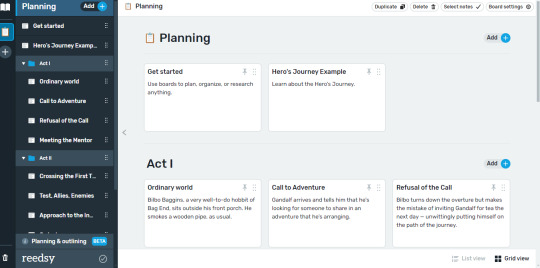
Also, don’t forget the various features available to you when creating your book in Reedsy. For instance, you have the option to include preset formatted pages such as a dedication page and an epigraph that resonates with your story. These features can add a lot of value to your book, and I encourage you to explore them further.
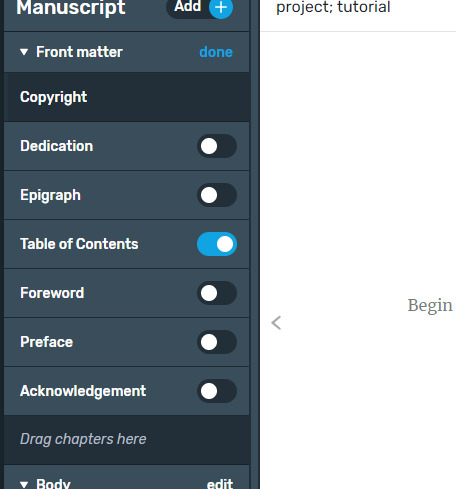
Hopefully this can help you understand the basics of Reedsy Book Editor. One of my favorite writing softwares that is completely FREE!
Hey fellow writers! I'm super excited to share that I've launched a Tumblr community. I'm inviting all of you to join my community. All you have to do is fill out this Google form, and I'll personally send you an invitation to join the Write Right Society on Tumblr! Can't wait to see your posts!

#writeblr#creative writing#thewriteadviceforwriters#writers on tumblr#writer things#writing#writing tips#on writing#writer#writer community#writing tools#writing resources#writing blog#writing advice#fiction writing#novel writing#author#book writing#publishing#indie author#fiction#reedsy#book editor#bookblr#self concept#bookworm#bookstore#books and reading#reading#book quotes
160 notes
·
View notes
Text
i think kim is just as complex of a character as harry, but i think a good amount of players (not all, but a chunk) choose to unflinchingly characterize him as “the Good Cop” and leave it at that.
#kim was a child of the revolution. he has faced racial discrimination all his life#even in a position of authority he still encounters overt racism while on the clock#but he has also killed. it's implied that the majority of his kill count comes from his time working with juveniles#he defends a police force that is corrupt and does jackshit- a tool of the coalition#the same coalition that was likely responsible for the death of both his parents#he used to be a moralist and claims to be apolitical#and yet there are times where he takes what are decidedly un-moralist left-wing stances#there is just so much there.#edit: turning off reblogs this post is oldddddd
834 notes
·
View notes
Text
Vegetari Village Ai Genarated
86 notes
·
View notes
Text
List of Furniture You Want, But Don't Know The Name of, Part I
──⭒─⭑─⭒────⭒─⭑─⭒──


᯽ Garden arbor
──⭒─⭑─⭒────⭒─⭑─⭒──


᯽ Tiffany style lamp
──⭒─⭑─⭒────⭒─⭑─⭒──


᯽ (Japanese) Koi pond
──⭒─⭑─⭒────⭒─⭑─⭒──


᯽ Conversation pit [sunken living room]
──⭒─⭑─⭒────⭒─⭑─⭒──


᯽ Bay window seat/bench
──⭒─⭑─⭒────⭒─⭑─⭒──
#writing woes#writing tips#writing tag#writing things#writing tool#writing thoughts#creative writing#writer#writeblr#writing#writers on tumblr#writers and poets#writerscommunity#writing advice#writer stuff#writer woes#write tag#write tip#furniture#house design#house decor#interior design#interior decorating#home interior#exterior design#exterior decor#author#home decor#decoration#decor
60 notes
·
View notes
Text
Writing Flaws
Yesterday I posted a list of random flaws to give your characters. Today, I'm posting a few tips about writing flaws :) Enjoy
Give your character a few. Everyone has multiple flaws and it's important when writing realistic characters to keep this in mind. Also remember; some are going to be more prominent or visible than others.
Give importance to their flaws. Whether their flaw of being nosy leads them into trouble or a new part of the story, make the flaws count. You don't have to incorporate all of them, or even one for each character, but make the flaws progress. This also helps if you get stuck writing. Another way to make them important is to have a character arc, simple but effective. Remember, it takes time to get out of old habits so even if the character grows they will likely retain bits of their old personality. It also keeps it interesting
Be consistent. Pretty easy to explain, if your character is dogmatic, don't allow them to be all accepting of a new ideology just to make writing easier.
Don't forget the little things. Apply their flaw to small parts of the story, this makes it more believeable and more interesting to read.
Thank you for reading, have a good day!
#writers#novel writing#writeblr#authors#writing#characters#write#write write write#character#flaw#traits#tips#writing tips#writing advice#writing resources#writing tools#writer tips
288 notes
·
View notes
Text




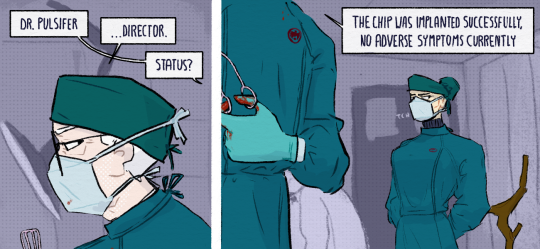
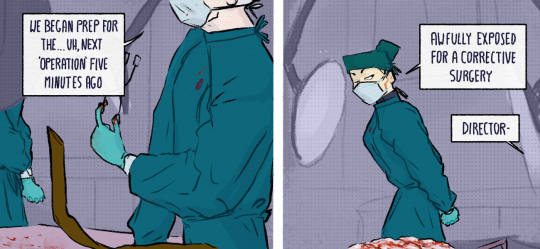


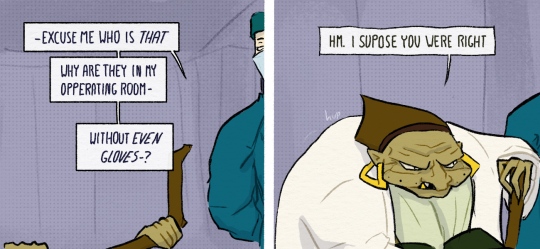

part 18 (gore)
yeah... you're kept conscious during neurosurgery, ahaha it's to make sure they aren't hitting anything too important
⇇ | ⇽ | index | ⇾
#rottmnt residuum comic#residuum#g#tw blood#tw gore#tw exposed bone#tw exposed brain#tw surgery#tw surgical tools#not putting this one in the rise tag#y'all i watched brain surgery for this#i mean so did co-author but thats beside the point#i severely underestimated my gore skills... would you believe i've never dawn gore before? ahaha#tw dehumanization#stand by for the censored version
735 notes
·
View notes
Text
Writing Rage: How To Make Your Characters Seem Angry
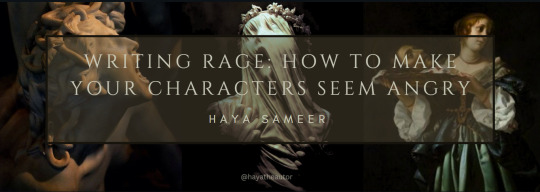
Anger is a powerful emotion that can add depth and intensity to your character's personality. If you're facing issues realistically expressing your characters' rage, here are some quick tips to help you get the ball rolling. Whether your character is seething with quiet rage or exploding in a fit of fury, these tips will help you convey their emotions vividly to your readers.
This is blog one in my writing different emotions series. Go check it out to explore more emotions!
Facial Expressions
Furrowed Brows: Describe the deep lines between their eyebrows, signaling frustration or intensity.
Tightened Jaw: Mention their clenched jaw, indicating suppressed anger or tension.
Narrowed Eyes: Highlight how their eyes narrow, showing suspicion, irritation, or anger.
Raised Upper Lip: Note the slight curl of the lip, suggesting disdain or contempt.
Flared Nostrils: Describe how their nostrils flare, indicating heightened emotions like anger or aggression.
Body Language and Gestures
Crossed Arms: Show their defensive stance, portraying resistance or defiance.
Pointing Finger: Describe them pointing accusatively, conveying aggression or assertion.
Fist Clenching: Mention their clenched fists, symbolizing anger or readiness for confrontation.
Hand Gestures: Detail specific hand movements like chopping motions, indicating frustration or emphasis.
Aggressive Posturing: Describe them leaning forward, invading personal space to intimidate or assert dominance.
Posture
Tense Shoulders: Highlight their raised or tense shoulders, indicating stress or readiness for conflict.
Upright Stance: Describe their rigid posture, showing control or a desire to appear strong.
Stiff Movements: Mention their jerky or abrupt movements, reflecting agitation or impatience.
Eye Contact
Intense Stares: Describe their intense or prolonged gaze, signaling confrontation or challenge.
Avoiding Eye Contact: Note how they avoid eye contact, suggesting discomfort or a desire to disengage.
Glaring: Mention how they glare at others, conveying hostility or disapproval.
Dialogue
Raised or strained tone with variations in pitch reflects heightened emotions.
Short, clipped sentences or abrupt pauses convey controlled anger.
Use of profanity or harsh language intensifies verbal expressions of anger.
Volume increase, from whispers to shouts, mirrors escalating anger levels.
Monotonous or sarcastic tone adds layers to angry dialogue.
Interruptions or talking over others signify impatience and frustration.
Aggressive verbal cues like "I can't believe..." or "How dare you..." express anger explicitly.
Reactions
Physical Reactions: Detail physical responses like increased heart rate, sweating, or trembling, showing emotional arousal.
Defensive Maneuvers: Describe how they react defensively if someone tries to touch or talk to them, such as stepping back or raising a hand to ward off contact.
Object Interaction
Aggressive Handling: Show them slamming objects, throwing things, or gripping items tightly, reflecting anger or aggression.
Use of Props: Mention how they use objects to emphasize their emotions, like slamming a door or clenching a pen.
Descriptive Words:
Verbs:
Roared with fury, expressing unbridled anger.
Snapped in frustration, indicating sudden irritation.
Shouted angrily, releasing pent-up emotions.
Glared fiercely, showing intense displeasure.
Slammed objects in rage, symbolizing anger's physical manifestation.
Grunted in annoyance, displaying impatience.
Raged vehemently, portraying uncontrolled anger.
Adjectives:
Furious and incensed, conveying intense anger.
Seething with rage, bubbling beneath the surface.
Livid and fuming, exhibiting visible anger.
Agitated and irritated, showing growing impatience.
Enraged and wrathful, expressing extreme anger.
Vexed and irate, indicating annoyance.
Infuriated and incandescent, highlighting explosive anger.
Looking For More Writing Tips And Tricks?
Are you an author looking for writing tips and tricks to better your manuscript? Or do you want to learn about how to get a literary agent, get published and properly market your book? Consider checking out the rest of Haya’s book blog where I post writing and publishing tips for authors every Monday and Thursday! And don’t forget to head over to my TikTok and Instagram profiles @hayatheauthor to learn more about my WIP and writing journey!
#hayatheauthor#haya's book blog#haya blogs#blog masterlist#writing community#writing tools#writer things#writing advice#writer community#writing techniques#writing prompt#writing stuff#creative writing#ya writing advice#writing tips and tricks#writer tools#writers of tumblr#writer blog#writers block#writers on tumblr#writerscommunity#writer stuff#author help#author advice#writing emotions#how to write emotions#emotional writing#writing#author
3K notes
·
View notes
Text
Alternative System Mind Mapping Method for Communication
[DISCLAIMER: This is not a professional or scientifically or anything really backed method, this is something coming solely from peer / personal experience.]
In regards to an anon ask earlier, I was thinking about it and one of the ways we've approached improving communication - particularly internal - in a way that is a lot less prone to flooding or dealing with trauma or anything too overwhelming - is by approaching it following the concept of Memory Webs
I haven't read up on them recently, but "Memory Webs" were a thing that our AP Psychology teacher in highschool made us do because the AP Psych test was term / jargon heavy. Memory in the human brain has been shown to be HEAVILY associative and the ability to remember and connect things tends to rely on following a "web" of connected topics, ideas, concepts etc from one idea to the next.
So in our AP Psych class, she gave us these GIANT books for Vocabulary Webs that we had to slowly work on, each of which required 6 other vocab words / related concepts, a summarized definition, and an image to represent it. By doing this, you added 6 cues to recall the word (increasing the chance you'd remember it), a visual cue, an episodic memory of working on it, and a definition - all in all improving how connected the word is to other concepts in your brain and making it easier to recall it.
I personally like to look at DID and our parts in a similar manner sometimes where the large issue is that a lot of the nodes in the web of associations are either disconnected or connected through a hard-to-find and/or small chain. In that sense, parts struggle to be held together because they are not associated concepts. It's hard to reach other parts because the dissociative walls (which in our unsubstantiated opinion is less a 'wall' and more so a lack of reinforced neural connections, so I would call them dissociative caverns) keep associations from forming
As a result, alternative to more traditional ways of mapping your system and parts, a method I've liked to internally visualize systems and navigating system dynamics is through a memory web manner. (I actually have never done it physically cause the Ray part of my brain - also the most prominent part writing this rn - rarely liked to front if he didn't have to and did a lot of stuff internally)
Here's a bit of a breakdown using six of our parts if any of you want to try it out.
We personally like it because it strips a lot of trauma and stress off of it and makes it a lot more of a positive and present engaging activity.
For the purposes of this, I'll be using the free online app of Milanote cause we've used it before for OC associative webs and I think it'll do fine enough.
(Honestly it actually might just be a good way to log alter information now that I'm looking at it if you are at a place in recovery where keeping track of that physically helpful)
So we can start by dropping down the parts we want to include in the form of boards

So from here, we have a bunch of disconnected parts. However, we find that a lot of these parts have things that mean a lot to them, that illicit a strong emotion or reaction from them.
Some parts may lack it more than others (often in our case trauma holders and/or trauma locked parts) and that's okay and to be expected. This is a visualization method and if there isn't much connecting a part that is 100% okay.
For demonstration sake, I will now add bubbles around each part of things that were pretty early apparent that each individual liked.
Also for the purposes of how I know our system works and how I plan to do this, I am actually moving Riku to the center and you will all see why Riku is such an S tier center point with this model
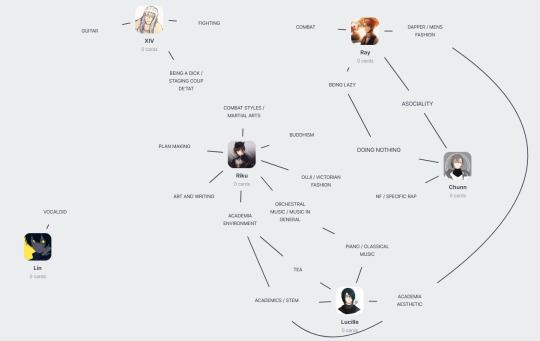
So you can see some connections forming.
Some key things you can take from this visual that also applied to earlier stags of how we connected
Lucille and Riku are and have always been pretty darn connected, they go back as one of the longest duos and were split almost as a pair to deal with academics
Chunn and Ray have a very shared interest of "I don't want to do anything leave me alone"
XIV literally was just a piece of shit early on and didn't have any immediate HARD connections with anyone largely because he never was interested in actually engaging in things he liked in a positive way as his "favorite emotion" at the time was "being pissed off"
Lin - an originally trauma stuck / loop - is very very poorly associated with anything that isn't overtly trauma related (and that is saying something cause Vocaloid is trauma related) and thus has very few connections to other parts
So looking at this though, there are a few things that have some similarities between parts. What you can do is make plans to try to foster the interests that you do have and try to generalize it a bit more to also encompass what interests other parts have. So lets engage in hobbies a little more - explore a few concepts that mean a lot to parts independently - and find some more generalized version of those hobbies
(forgot to add easy listening to Ray's and "only wearing monochrome*" to XIV's earlier)
(*there are a lot of nuances and caveats)
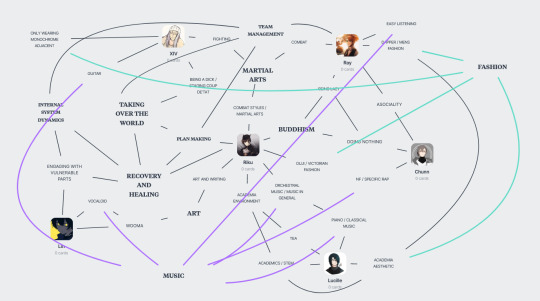
Damn, look at that. It's messy and ugly to have in a 2D form. I absolutely hate it, this would be so impossible with our whole system. But HEY, it's very connected - and that's the goal.
Compared to the previous one, you can see how easily it can be for one part's interests to start to drift into another. Because they are largely and strongly associated features to each part, they are a lot more accessible when engaging in their shared / associated connections and interests which makes it easier for the them to stay together near the front, stay associated with one another, and work with and communicate with one another.
Of course anyone following this blog goes "Where tf is Birds" and that I left out because it would ruin the point of the web as it actually is one of our traditional "you are around the system a lot? okay pick a bird" which serves to 1) be a fun system culture thing 2) be a means of welcoming a part in and 3) helps establish a foundational connection; we do the same with music but with music its a lot more elaborate and I probably wont explain it for other reasons.
But overtime, by fostering interests that were already present and encouraging parts to broaden and generalize their specific interest a bit, you end up with a lot of overlapping associations that can greatly improve internal communication, co-fronting ability, and just general fluidity and easy of moving around the brain web.
It becomes a good way of trying to figure out what you can do to encourage and help build connections and associations between parts by seeing where things are similar / could have more overlap (combat and martial arts, different types of fashion, different types of music, different appreciation for arts, taking over the world, yada yada yada)
And you wanna know the coolest thing? When you step back from the whole web you can see certain things appear that stand out the most and have some of the most connections.
If you ever intend to go to Final Fusion, those are the things that will likely be the most prominent traits of your whole self
For us? [REDACTED BIRDS for the point of the demonstration], Music, Fashion, Taking over the World, Recovery and Healing, Buddhism, Martial Arts, Arts in general - they're all some of our largest traits that persist in almost all forms as individual parts, partially fused parts, and fully fused parts.
And the BEST part? Doing this didn't require us to touch trauma at all.
Of course in recovery that will come up cause PTSD doesn't ask permission, but its a very low stress way to help improve internal communication and engagement with one another.
#actuallydid#dissociative identity disorder#resources#advice#internal communication#integration#feather's unsubstantiated theraputic tools#unsubstantiated advice#alter: fei#final fusion#functional multiplicity#wishiwashi recovery#system mapping#system map#mind mapping#mindmap#recovery#healing#alter: ray#<- heavily authored by that part of this brain#system dynamics
178 notes
·
View notes
Text


Extra Comic— What’s Lily up to? (Read left to right)
Text:
This is Lily at the beginning. She grew up without any worries… Well, except for the fact she sees things no one else can see… and the awful dreams she can hardly recall—she’s doing fine.
It’s been awhile since we’ve seen Lily in the story! You can’t help but wonder how the protagonist of the world is doing sometimes, but even though she’s not onscreen, she’s been okay.
#If anyone’s wondering yeah that’s Kim Roksoo in the third panel LOL#I hate using the procreate text tool because it annoys me so I didn’t use it#but now I’m kinda regretting it cause my handwriting is bad but WHATEVER!#tcf fanfic#fanfic fanart#is it fanart if I’m the author?#tcf#lcf#lily henituse
35 notes
·
View notes
Text
How to Build a Sustainable Writing Habit Through SCIENCE (Fuck Off, NaNoWriMo)

This is a lightly edited repost from a previous post on my mostly-defunct blog, topazadine.com. I feel like it's an excellent thing to highlight now that everyone's wondering what the hell do to after NaNoWriMo showed their ass as anti-creative idiots.
I have never liked NaNoWriMo and think, frankly, that it is a garbage tool for new writers. If you've done it and enjoyed it, that's great, but overall, it is not the best way to build motivation. At all.
But why is NaNoWriMo so bad? (Other than the current controversy.)
It encourages younger writers to think of writing as something they do during the months of October through November. Not something they do all year round, day in and day out. People will prep for weeks to do a whole novel in one month and hinge all their writerly hopes on that one singular month.
We won't even get into the fact that November is the absolute shittiest month to try to get a novel done because the holidays are coming up, and many working-class people are busting their asses off to get extra hours in before Christmas.
Writing is something you do all. the. time. It is not bound by a singular month. It is not limited to a certain time of year. And when you are working to complete a draft, it doesn't matter season it is. What matters is that you get it done.
So let me show you something better. But first, why should you listen to me? And why is my method an improvement over a shitty organization's AI-riddled contest?
I wrote the first draft of my novel, Poesy (104,323 words) in 39 days.
That’s an average of 2,647 words per day. It is also about twice as much as the typical person aims for during NaNoWriMo. I did not set out to get it done in any given time period, but I still completed way, way more than NaNoWriMo would require in just about the same amount of time (plus 9 days).
I didn't have a buddy group. I didn't have checkins. I just had me and my keyboard and my secret weapon, which I'll show you in a bit.
How is it possible to get so much more done without that external motivator?
Simple: I compete with myself.
You Need to Develop Intrinsic Motivation
What in the world is intrinsic motivation?
Intrinsic motivation is defined as the doing of an activity for its inherent satisfaction rather than for some separable consequence. When intrinsically motivated, a person is moved to act for the fun or challenge entailed rather than because of external products, pressures, or rewards.
Frontiers in Neurobiotics
That is, in essence, what we do when we’re writing for fun; or, rather, it should be what we’re doing when we write for fun.
A lack of intrinsic motivation is why people who see novels as a get-rich-quick scheme tend to burn out when they realize that most writers make less than minimum wage. That's called extrinsic motivation, and it doesn't work well for things like writing, where there may not be any easily-defined goals or motivators. Most of us are not going to become rich from our writing.
Here's why extrinsic motivation is unhelpful:
Extrinsic motivation does not always work best; sometimes it can make us perform poorly at certain tasks.
For instance, studies reveal that high stake rewards, like cash bonuses, can hinder cognitive capacity. This happens because they shift our focus away from the task and onto the outcome. We can become preoccupied with rewards and all the things that come with them, such as our social status, instead of just doing the work.
Extrinsic rewards also tend to narrow our focus on a defined goal and reduce our ability to see other possibilities, hindering creativity. Studies find people perform worse on tasks requiring imagination and ingenuity when they are offered extrinsic rewards, such as higher pay.
Nir and Far
And, well, note that "performing worse on tasks requiring imagination and ingenuity." Extrinsic motivation is literally the WORST motivator for writing specifically.
NaNoWriMo is extrinsic motivation, which is not anywhere near as powerful or sustaining as intrinsic motivation. You want to get the shiny achievement award, so you just bang out 50,000 words of slop because you want to say you did it.
You're not motivated by anything but the outcome. That does not a sustainable writing practice make.
But there’s something about intrinsic motivation I want to highlight, because it’s crucial to what I am about to show you: the challenge.
Sometimes writing is a total slog because we’re worrying about all the other things and not on the words themselves. We’re fussing about whether we will ever get published, if we’ve added enough tension in a certain part, if our mom is going to read our porn and realize what a freak they raised.
You cannot think about those things while actively writing.
Instead, you need to focus on the writing process itself. John Schinnerer, a psychologist and life coach, explains further:
Remember as you are in the process of achieving your goals that the enjoyment comes from the doing not the attaining. It is important to find contentment in the act of pursuing the goal while placing less weight on the actual fulfillment of the goal itself.
PsychCentral
So we know you need to find the challenge fun, and you need to focus on the act of putting the words on the page.
In other words, you need to make it a contest with yourself. Here’s how.
Use a Word Count Spreadsheet
Finally! We get to why I’m telling you this! It's free, it's easy, it can be done all year round.
A daily word count spreadsheet is an amazing way to stay motivated and to keep pushing yourself to write because you can literally see the wins rack up. Every day, the word count jumps significantly, which can be much more motivating than just “oh, I’m at 8,453 words.”
More importantly, you’ll start to want to beat your “high score” from the day before.

I’ve highlighted one of the cells so that you can see the simple formula that you need to set up: it’s just yesterday’s count minus today’s count.
Put that in one cell, then click and drag the bottom righthand corner of the cell, and it will populate the rest of the cells in that column with the adjusted formula (B4-B3, and so on).
This is very easy to create. All you have to do is copy-paste the wordcount from your document into your spreadsheet, make sure you have that super-simple formula, and you're done. I have severe dyscalculia and can still use it.
But you can see how much this really helped me:

Things started to really ramp up right at the end because I was getting so motivated by the word counts of the day previous. I wanted to beat yesterday’s high score and keep going.
At the beginning, I was writing maybe 1.9k words; by the end, I was an absolute demon, regularly breaking over 2.8k and then some. On the last day, when the rest of the family was in a post-Christmas hangover, my butt was glued to my chair, banging out those last few thousand words.
Psychologists and life coaches agree that self-competition, a type of intrinsic motivation, is one of the best ways to improve.
Michelle Gibbings, a workplace expert, explains:
When you compete with yourself, you don’t become fixated on what other people are doing; you set the direction and speed. You put yourself in the driver’s seat and control your progress, setting meaningful goals rather than focusing on the progress of others.
Michelle Gibbings
Making a word count spreadsheet like this is the definition of setting your own speed and controlling your progress. You can decide on a threshold you always want to hit and then feel very satisfied when you go beyond that.
I set my threshold at 1.5k words every day so that I didn’t feel bummed out when I had an off day and couldn’t get a lot done, but I really wanted my average to be around 2k, so I’d periodically check how close I was to that. If I had a terrible day or was busy, then I’d want to make up for lost time and write more the next day so I kept my average.
Now, I live a life that is quite advantageous to consistent writing: I’m single, I’m childless, I work from home, and most of my hobbies are pretty low-key.
Your life doesn’t look like mine, and that’s totally okay.
There’s no need to match the speed I showed here.
What matters is that your schedule works for you, and that you are consistent.
If you’re a caretaker or have a strenuous job, then set your threshold at just 100 words and aim for an average of 500. However, you’ll be sad if your spreadsheet has a blank cell, so you’ll want to get down at least something, even if you only have 15 minutes to write.
Plus, it’s so encouraging to see the word count go up day by day: much more satisfying than just seeing it in tiny font at the bottom of a Word document or Google Doc.
Or getting some dumb t-shirt from an organization that is actively trying to murder creativity for commercial gain. (Oh, and they protected an actual pedophile from consequences for months on end while he continued to groom children. But that was last year's controversy.)
There’s another reason why this particular method works so well for writers, though.
Word Counts Banish the Urge to Edit
You know you shouldn’t, but you do it anyway. A single word here. A removed sentence there.
The first draft is just about getting everything out, not fixing everything that needs fixing. That part comes later during your five billion revisions where you tweak every single word.
Revising means you have less to work with, which means you have less development. You can get rid of anything that shouldn’t be there when you’ve gotten to that very satisfying “The End” page.
If you are motivated by the spreadsheet method, then you are screwing yourself over if you edit.
Your word count went down! It looks like you did less than you did! You’re losing! Best add more, and fast!

(I had to include my placeholder chapter names; it was obligatory.)
Use strikethrough! Now you know exactly what you’ll be getting rid of when you get to the end of your draft, but you’re not decimating your word count. I removed the entire beginning of the book; that scene is super cute, though, so I later turned it into its own one-shot on my AO3 page.
I prefer doing that because then, if you find that you actually wanted to keep that scene or move it elsewhere, all you have to do is copy-paste from the old version, remove the strikethrough, and you’re all good.
So that’s my tool. It’s really that simple.
But even though it’s so simple, it works wonders for your motivation and consistency, which are crucial for a good writer.
Are you going to give it a whirl? You may find it nervewracking at first, but I encourage you to sample this method, especially if you have a hard time getting motivated.
And if you enjoyed this article, maybe you'll consider purchasing my debut novel, 9 Years Yearning.
This is not the book I drafted last year; it is in fact a prequel of sorts to that first novel. However, it helps set the scene for Poesy (the sixth book in the Eirenic Verses) so that you'll be all prepped for the masterpiece.
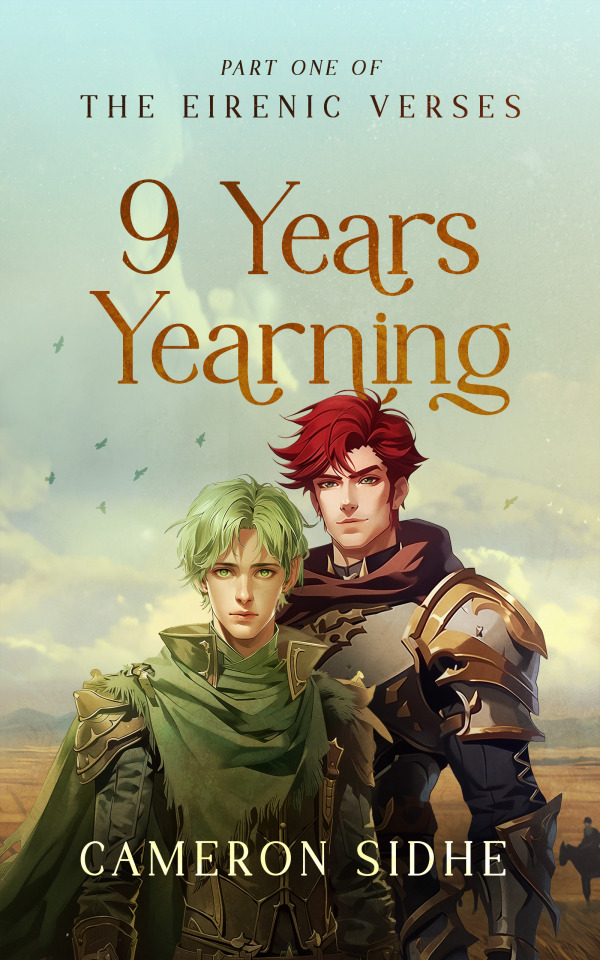
9 Years Yearning is a coming of age romance that follows the life of two young soldiers as they go from sorta-enemies, to frenemies, to friends, and then finally to lovers. It is a short read; you can probably finish it in about 2 hours all the way through. Perfect for a weekend romp.
If you do read my book, please don't forget to leave a review!
Reviews are essential to success on Amazon as they boost visibility. (Yes, even bad ones.) Always leave reviews, no matter how short, to support indie authors!
#nanowrimo#national novel writing month#writing community#tumblr writing community#writers on tumblr#writeblr#creative writing#writerscommunity#writer#writers of tumblr#aspiring writer#aspiring author#writing blog#fiction writing#writblr#novel writing#writer stuff#writing tips#writing a book#writing advice#writing tools#writing help#how to write#on writing#writing stuff#writing process#writing problems#writing is hard#writer problems#beginner writer
46 notes
·
View notes
Text
Floriography: Resources for Writers
For centuries, flowers, herbs, and other plants have been used to convey meaning, both in life and in literature. Many of the greats, including Shakespeare, Austen, the Brontë sisters, and Steinbeck referred to floral symbolism to delicately weave into their intricate works. Flowers influenced art for generations before us, and with luck, they will continue to inspire artists for generations after us--long after we've become them.
Victorian Floral Code.pdf
Floriography: An Illustrated Guide to the Victorian Flower Language by Jessica Roux
Language of Flowers Wiki
Hanakotoba - Japanese Flower Language Wiki
Ikebana - Japanese Flower Arrangement Wiki
Kate Greenaway's Language of Flowers
Floral Emblem Guide
Plant Motifs In English, Russian, and Tatar (pdf)
Flower Language Myths
Language of Flowers.com
#culture#language#writers#author#writing reference#reference#victorian flower language#poets on tumblr#japanese folklore#slavic folklore#motifs#creative writing#indie author#floriography#for future reference#resources#writing tips#writing advice#writing tools
210 notes
·
View notes